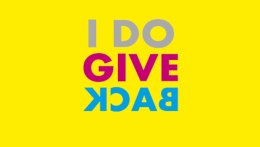Mareike Dörr
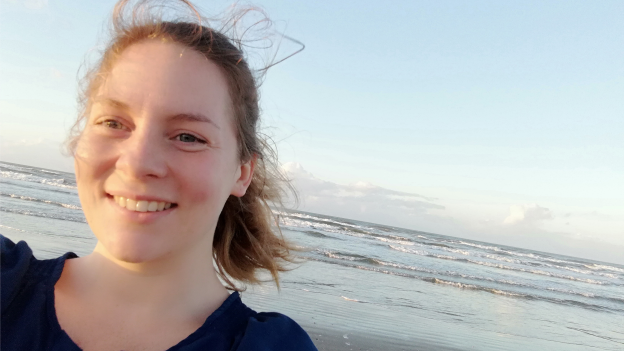
Aside from campus Mareike Dörr also spends some of her time at Galveston's beach
"The four months of my stay went by in a flash... I think I was able to make myself useful in my host lab due to my expertise, and I certainly learned a lot myself. Finally, I want to thank all of the people who assisted me in Germany and in America, who helped make this trip possible."
Mareike Dörr is a postgraduate of veterinary medicine whose academic focus while working on her doctoral thesis lies in the field of virology. Thanks to a donation by the Prof. Dr. Bingel-Stiftung she was awarded with a Research Stay by the DAAD-Stiftung which Mareike Dörr spent in the United States of America.
Here she recounts her experiences in Texas:
Research
In my doctoral thesis, I address the research of viral adaptation to the host, comparing the genetic adaptation mechanisms of the West Nile virus (WNV) and the Canine Distemper virus (CDV). The outstanding adaptability of viruses is due to their quick generation change and high mutation rates during genome replication. In practice, this means that a patient is never infected with just one virus genotype but with many different genotypes. The interactions of these genotypes in the host and new mutations are relevant for the progress of the infection with many viruses. Some viruses, like WNV and CDV, can infect their host’s brain under unfavourable developments, which can have fatal consequences. Researching the viral factors leading to these developments can result in greater understanding of these viruses, which in turn can lead to new treatments.
For the portion of my research that deals with the West Nile virus, it was clear from the beginning that it would have to be conducted at the premises of a cooperation partner, as the Paul Ehrlich Institute is not at this time equipped to work with the (wild type, natural) WNV. During a conversation with Dennis Bente, who leads a research group at the University of Texas Medical Branch (UTMB), we realised that one of his doctoral candidates is working on a similar topic, and that my method of genetic analysis (deep sequencing of viral genotypes) would complement his work very well while allowing me to gather data for my own doctoral thesis. This conversation finally resulted in exact experiment plans and agreement on a time frame for said testing. At the same time I gathered some information about scholarships and also applied with the DAAD. I ultimately received the short-term scholarship for doctoral candidates by the DAAD-Stiftung in cooperation with the Prof. Dr. Bingel-Stiftung and was able to finalise my research plans.
Project Progress
After I had been authorised by the UTMB to work at the lab, I and my supervising PhD student Corey immediately started running the experiments and tests we had planned. By staining mouse brain sections based on immunohistochemistry, we were able to visualise inflammations in the brain particularly in acute phases of illness. This is made possible by binding specific antibodies to proteins linked to the inflammation. Using a staining technique specific to the virus, we intend to establish the correlation of the inflammation with the virus as the project progresses. To analyse the genetic adaptation, we prepared 132 samples and isolated the RNA that contains all of the viral genotypes and their mRNA transcripts. In addition, I was able to prepare the deep sequencing but ultimately was not able to carry out all of it. However, this can also be done by others after my return to my home university. We can analyse the sequencing data in Germany in cooperation with the “Molecular Genomics Core” at UTMB.
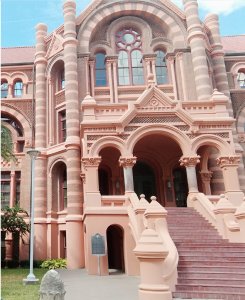
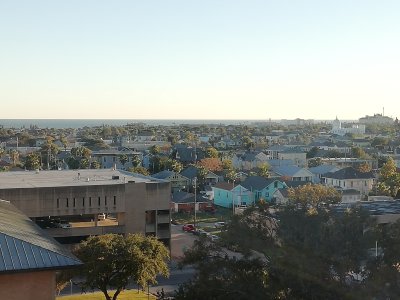
Left: the “Big Red” university building, the oldest building at UTMB; right: view from the lab window
Organisation on site
DurThanks to the already existing friendship with a PhD student in my guest lab, I was easily able to organise sub-letting a room, which was a big relief. Also, my work group at the lab arranged my trip to and from the airport. In all official processes, everyone (my own institute, the DAAD-Stiftung and my guest institute) was very friendly, helpful, patient and quick, for which I want to thank them at this point! In retrospect, though the organisational effort was considerable, it was manageable as it was divided over several months. Still, I was somewhat surprised at the number of forms and the mass of information I had to provide to the USA before I was allowed to work at the lab there.
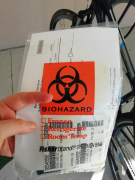
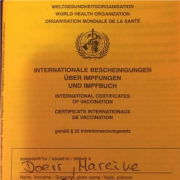
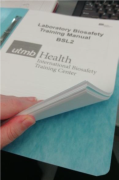
In order to gain access to the lab, I had to give a blood sample (left), show a current immunisation record (centre) and take a bio-safety level 2 (BSL2) course (course materials right).
Other projects
In addition to work on my project, I learned how to isolate splenocytes and gained significant insights into the work in high-security level 3 labs. The university in Texas gave me the opportunity to take courses for safety levels 2 and 3. The trainers were considerate of the fact that my time on site was limited and accelerated some of the processes for me. That way I was able to take practical and theoretical exams at both levels and ultimately earned the respective certificates.
Integration in daily life in America
Right after my arrival at the airport in Texas, I was invited to my first dinner with the entire lab and I had a chance to meet everyone right away. Communication was significantly easier because one post-doc and my group leader at the lab were Germans. This was one of the reasons we had a humorous discussion about the peculiarities of German and American culture right on the first evening. During my time abroad my supervisor Corey involved me in all of his academic questions. Thanks to our different backgrounds (his in veterinary medicine, mine in biochemistry) we complemented each other wonderfully. We also got along well at the personal level and he had a lot of funny anecdotes to tell from his time in veterinarian’s training.
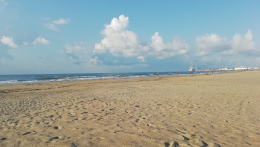
Privat
Apart from many institute festivities, lectures with subsequent discussion and the great sports programme at the university, the island of Galveston offered a large variety of leisure activities, such as the beach, many restaurants and “Moody Gardens”, a combination of aquarium, botanical garden and zoo.
I also visited the “Galveston Oktoberfest”, where a lot of German specialities like Apfelstrudel, Bratwurst and Laugenbrezeln were served. There I met nearly everyone from my lab and a few other university employees, many even wearing typical or nontypical Oktoberfest outfits.Overall, I was very well integrated even outside of work and never bored thanks to the many university events.
Conclusion
The four months of my stay went by in a flash... During my time in Texas, I was able to progress with the project almost as far as I had originally planned. Luckily, the remaining analyses can also be carried out in cooperation between my home and guest universities. I think I was able to make myself useful in my host lab due to my expertise, and I certainly learned a lot myself. On the whole, it is a very promising subject area. I expect to receive the remaining data in the near future and anticipate a publication about them somewhat later. In addition, I was able to gain a lot of knowledge about the work and organisation of high-security labs and on the subject of immunohistochemistry. Both will benefit me in my professional career. Furthermore, I had a chance to improve my English and expand my academic contact network. I already look forward to seeing many of my newly made contacts again at international conferences.
Finally, I want to thank all of the people who assisted me in Germany and in America, who helped make this trip possible. I am grateful for the administrative help I received from the employees of the Paul-Ehrlich Institute and the University of Texas Medical Branch. Moral and organisational support were provided by my colleagues in Germany and my group lead, Veronika von Messling. My visit would not have been possible without the active assistance of Dennis Bente; the members of his lab group are not only friendly and helpful people, they are also passionate scientists. I also thank Corey for the academic exchange and supervision at the lab.
Of course I would be amiss not to thank the DAAD-Stiftung, as the financing I received was a great relief and allowed me to have a “worry-free” visit.
As of winter 2018/19. The German version is the original.


